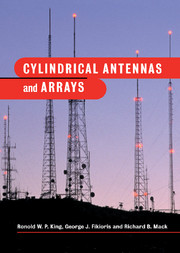Book contents
- Frontmatter
- Contents
- Preface
- Preface to first edition
- 1 Introduction
- 2 An approximate analysis of the cylindrical antenna
- 3 The two-element array
- 4 The circular array
- 5 The circuit and radiating properties of curtain arrays
- 6 Arrays with unequal elements: parasitic and log-periodic antennas
- 7 Planar and three-dimensional arrays
- 8 Vertical dipoles on and over the earth or sea
- 9 Dipoles parallel to the plane boundaries of layered regions; horizontal dipole over, on, and in the earth or sea
- 10 Application of the two-term theory to general arrays of parallel non-staggered elements
- 11 Resonances in large circular arrays of perfectly conducting dipoles
- 12 Resonances in large circular arrays of highly conducting dipoles
- 13 Direct numerical methods: a detailed discussion
- 14 Techniques and theory of measurements
- Appendix I Tables of Ψd R, T(m) or T′(m) and self-and mutual admittances for single elements and circular arrays
- Appendix II Tables of matrix elements Φu and Φυ for curtain arrays
- Appendix III Tables of admittance and impedance for curtain arrays
- References
- List of symbols
- Index
12 - Resonances in large circular arrays of highly conducting dipoles
Published online by Cambridge University Press: 07 August 2009
- Frontmatter
- Contents
- Preface
- Preface to first edition
- 1 Introduction
- 2 An approximate analysis of the cylindrical antenna
- 3 The two-element array
- 4 The circular array
- 5 The circuit and radiating properties of curtain arrays
- 6 Arrays with unequal elements: parasitic and log-periodic antennas
- 7 Planar and three-dimensional arrays
- 8 Vertical dipoles on and over the earth or sea
- 9 Dipoles parallel to the plane boundaries of layered regions; horizontal dipole over, on, and in the earth or sea
- 10 Application of the two-term theory to general arrays of parallel non-staggered elements
- 11 Resonances in large circular arrays of perfectly conducting dipoles
- 12 Resonances in large circular arrays of highly conducting dipoles
- 13 Direct numerical methods: a detailed discussion
- 14 Techniques and theory of measurements
- Appendix I Tables of Ψd R, T(m) or T′(m) and self-and mutual admittances for single elements and circular arrays
- Appendix II Tables of matrix elements Φu and Φυ for curtain arrays
- Appendix III Tables of admittance and impedance for curtain arrays
- References
- List of symbols
- Index
Summary
In Chapter 11, the phenomenon of resonances in large circular arrays of dipoles is discussed. It is assumed throughout that the dipoles are perfectly conducting. The effect of ohmic losses is considered in this chapter. It is assumed here that one dipole is driven. The case where two dipoles are driven is a very simple extension. In Sections 12.1–12.6, an array of highly conducting dipoles in free space is examined. The two-term theory is extended so that it applies to this theoretical model. The model is mathematically equivalent to the physically unrealizable one of an array consisting of highly conducting monopoles over a ground plane which is perfectly conducting: one can determine the currents in the latter model by multiplying those of the former by a factor of 2.
The case of a circular array of highly conducting monopoles over a highly conducting ground plane is examined briefly in Section 12.7. An approximate method is outlined which allows calculation of the admittances in this case by slightly modifying the theory of Sections 12.1–12.6 in which a lossless ground plane is assumed. The model of Section 12.7 closely approximates experimental conditions. The theoretical curve (driving-point admittance as a function of frequency) obtained after the effect of the imperfectly conducting ground plane is taken into account is compared in this section to a corresponding experimental curve and the agreement is very good.
Information
- Type
- Chapter
- Information
- Cylindrical Antennas and Arrays , pp. 425 - 451Publisher: Cambridge University PressPrint publication year: 2002
